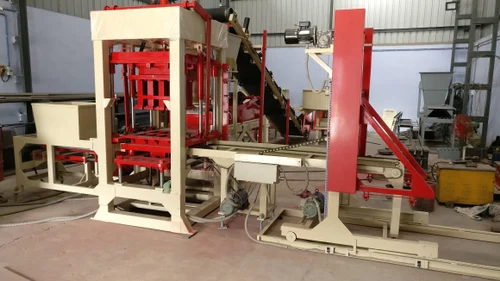
Vibration Block Making Machine
A Vibration Block Making Machine is used to produce concrete blocks (solid, hollow, paver, fly ash, etc.) using mechanical vibration technology. Instead of hydraulic pressure alone, this machine compacts concrete using high-frequency vibrations, ensuring better density, dimensional accuracy, and surface finish.
These machines are widely used in the construction and precast industry for high-volume, fast-paced block production.
| Component | Material | Function |
|---|---|---|
| Frame/Structure | ISMC / MS Steel | Structural support and durability |
| Vibration Table | Platform for molds; delivers high-frequency vibration | |
| Electric Vibrators | Industrial Grade Motors | Generate mechanical vibration (up to 6000 RPM) |
| Mould & Die Set | EN8 / Cast Iron | Shapes the concrete blocks |
| Feeder Hopper | MS Sheet | Holds and feeds raw material mix into the mold |
| Control Panel | Manual/PLC | Controls timing, vibration intensity, and cycle |
| Wheels (optional) | Rubberized Castor |
Frame Fabrication: Heavy-duty steel channels are welded to form the base.
Mold Manufacturing: CNC-machined molds for accurate block shape and size.
Motor Installation: Vibrators are fixed under the platform and connected to the panel.
Testing & Calibration: Vibrational frequency, amplitude, and timer settings are tested.
Feeding: Cement, sand, fly ash, stone dust, and aggregates are manually or automatically loaded into the mold.
Vibration: The vibrator motors create high-frequency vertical and/or horizontal vibration.
Compaction: Vibration compacts the mixture in the mold, removing air voids and increasing density.
Ejection: Once set, blocks are manually or automatically ejected from the mold.
Curing: Blocks are then cured (via water or steam) for 728 days.
| Specification | Value |
|---|---|
| Power | 310 HP |
| Capacity | 8005000 blocks/day |
| Vibration Frequency | 30006000 RPM |
| Block Types | Hollow, Solid, Fly Ash, Paver |
| Block Size | Customizable |
| Operation |
Manufacturing concrete blocks (solid & hollow)
Fly ash and cement brick/block production
Paver and interlocking tile manufacturing
Civil engineering test blocks
Speed: Ideal for bulk block production in a short time.
Precision: Ensures dimensional accuracy and finish.
Consistency: Each block has uniform strength.
Saves Labor: Reduces manual compaction or hand-molding needs.
| Advantage | Description |
|---|---|
| High Compaction | Vibration removes air gaps, increasing block strength |
| Continuous Output | High cycle rate for non-stop production |
| Easy Maintenance | Simple mechanical parts with fewer breakdowns |
| Dimensional Accuracy | Excellent surface finish and size control |
| Low Operation Cost | Less energy than hydraulic-only systems |
| Flexible Molds | Switch between block sizes easily |
| Portable (in some models) | Ideal for on-site production |
Brick/block manufacturing plants
Road construction departments
Municipal and government contractors
Engineering colleges and training institutes
Rural housing development programs
A: Cement, sand, fly ash, stone dust, gravel, water, and sometimes plasticizers.
A: Yes, 728 days of water or steam curing ensures the block reaches required strength.
A: Yes, with proper mold changeover and sometimes added vibration frequency.
A:
Hydraulic: Higher strength, used for load-bearing blocks.
Vibration: Faster, better surface finish, ideal for decorative or light-load applications.
A: With regular maintenance, 812 years or more.
The Vibration Block Making Machine is a vital asset in the precast and construction material industry. It is not only cost-effective but also increases production efficiency, product quality, and labor productivity, making it an indispensable machine in the age of mass infrastructure development.
The Vibration Block Making Machine is a highly efficient, reliable, and user-friendly machine designed for high-volume, high-speed, and high-quality block production. Whether you're in the fly ash block business, paver manufacturing, or construction contracting, this machine ensures cost-effective production with minimal manpower and maximum output.
Office Address
C-1, 77/1, Kaka Estate, Ambicanagar Road, Nr. National Plastic, Odhav, Ahmedabad β 382415, Gujarat, India.
Factroy Address
24, Shreeji Estate Near Sankalp Estate, Bakrol Cir, Ahmedabad-382430, Gujarat, India
mixwellindia@gmail.com
hardicengineering@gmail.com
+91 99042 01922
+91 98984 74351
Also Send Mail
© Hardic Engineering . All Rights Reserved.
